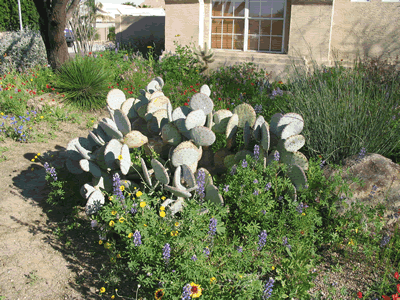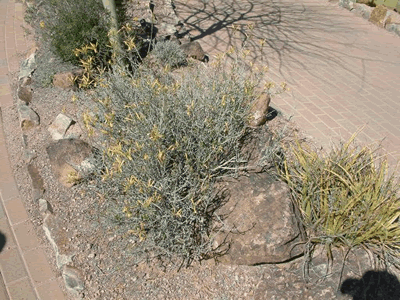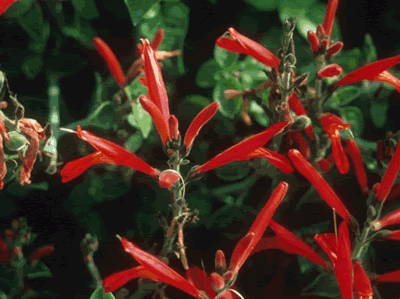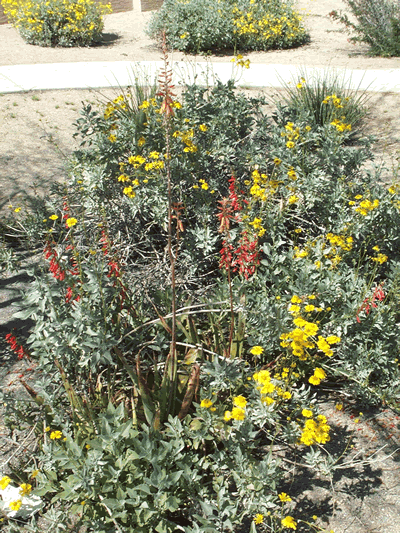Seasonal Color Combinations for Your Landscape
We live in a colorful world! Desert adapted plants offer exciting opportunities to add color in desert gardens. A wealth of plant material provides color nearly year-round in our desert landscapes.

The yellow lantana and purple flowers of the Texas sage make a great contrast.
What is Color?
Color is light, and light is composed of many colors. Those we see are colors of the visual spectrum red, orange, yellow, green, blue, and violet. Primary colors include red, yellow, and blue. All colors are made from combinations of white, black, and these primary colors. Secondary colors include orange, green, and purple.

Color can be envisioned as having three dimensions. The first dimension hue is the quality by which colors are distinguished from each other. The second dimension value defines the quality of lightness or darkness within a color. Those values darker than a particular color are called shades, while lighter values are called tints. The third dimension of color is intensity. Intensity defines the strength or weakness of a color or its brightness or grayness.

Lupines dance among the purple pads of the Santa Rita Prickly Pear Cactus.
Color in the Landscape
Colors are further differentiated into warm and cool colors. Warm colors include yellow, orange, and red. Cool colors include green, blue-green, blue, and violet. Warm colors appear to be aggressive and stand out in the landscape. Theyare excellent for dramatic displays, as demonstrated by Red Bird of Paradise (Caesalpinia pulcherrima). Cool colors appear to recede in the landscape and are good for close up viewing. Agaves with blue leaves can suggest cool and calm in a garden.
Bring color into a desert garden with foliage and flowers, colorful wall treatments, artwork, and creative hardscapes. Be sure to check with your homeowners association to make sure you comply with their regulations. Gardens can come alive when wall colors such as yellow are used as background for Purple Prickly Pear (Opuntia santa-rita). Red garden walls contrast to the yellow flowers of Palo Verde trees. Orange walls look great with the blue green leaves of the Octopus Agave (Agave vilmoriniana).

The blue green leaves of the Octopus Agave look striking against an orange wall.
Deep green desert trees such as Sweet Acacia (Acacia farnesiana) can serve as the background for blue-green accents such as Sotol (Dasylirion wheeleri). Contrast foliage and flower color by combining the deep green foliage and purple flowers of Mescal Bean (Sophora secundiflora) with the gray foliage and yellow flowers of Desert Marigold (Baileya multiradiata).
Color your desert garden with creative plant combinations!
Winter Combinations
| • | Brittlebush (Encelia farinosa) & Chuparosa (Justicia californica) |
These two Arizona native shrubs provide contrasting winter color in a desert garden. Bright red flowers of Chuparosa also attract hummingbirds and brilliant yellow flowers of Brittlebush burst with color in late winter months.
| • | Red & Yellow Chuparosa (Justicia californica) |
From early winter through midspring, the brilliant red flowers typical of Chuparosa make a great combination with its yellow-flowered clone.


| • | Tree Aloe (Aloe ferox) & Blue Euphorbia (Euphorbia rigida) |
Add excitement to the winter garden and attract hummingbirds too with the red-orange flowers of Tree Aloe, a South African leaf succulent. Create a stunning combination with the unusual citron-yellow flowers of Blue Euphorbia, a groundcover from the Mediterranean region.
| • | Purple Prickly Pear (Opuntia santa-rita) & Damianita (Chrysactinia mexicana) |
During the winter Purple Prickly Pear turns a deep purple and offers the added dimension of living garden sculpture. Combine with the green foliage and yellow flowers of groundcover Damianita for a distinctive contrast.
| • | Firecracker Penstemon (Penstemon eatonii) & Angelita Daisy (Hymenoxys acaulis) |
Long-blooming wildflowers entice hummingbirds into the garden and offer long-lasting winter color. Vivid red flowers of the Arizona native perennial Firecracker Penstemon combine with intense yellow flowers of the perennial groundcover Angelita Daisy to provide color nearly year-round.
| • | Firecracker Penstemon (Penstemon eatonii) & Golden Barrel (Echinocactus grusonii) |
A unique floral and foliage combination is created with the deep yellow spines of Golden Barrel and the brilliant red flowers of Firecracker Penstemon. Golden Barrels lend themselves to mass plantings in three, five, seven or more plants and add sparkle in the landscape. Interplant with Firecracker Penstemon in the fall for a spectacular red-yellow landscape combination in early winter.
| • | Firecracker Penstemon (Penstemon eatonii) & Desert Marigold (Baileya multiradiata) |
For color from winter through spring, the gray foliage and yellow flowers of Desert Marigold can be combined with green foliage and red flowers of Firecracker Penstemon to create an enduring Arizona wildflower display.
| • | Pea Bush (Dalea pulchra) & Fairy Duster (Calliandra eriophylla) |
Lacy green foliage and pink flowers of Fairy Duster make an excellent combination with the gray foliage and purple-pink flowers of Arizona native Pea Bush.
| • | Lilac Vine (Hardenbergia comptoniana) & Trailing Gazania (Gazania rigens) |
Iridescent purple flowers and deep green leaves of the Australian Lilac Vine liven up the winter landscape. Create an eye-catching combination by adding the yellow flowers and gray foliage of Trailing Gazania in the planting.
Spring Combinations
| • | Mexican Gold Poppy (Eschscholzia californica ssp. mexicana) & Arizona Lupine (Lupinus arizonicus) |
Golden yellow-orange flowers of Mexican Gold Poppy planted along with brilliant blue flowers of Arizona Lupine characterize an outstanding Arizona wildflower combination. Sow this spring wildflower combination in the fall along with other early flowering wildflowers.
| • | Tiger Aloe (Aloe maculata) & Brittlebush (Encelia farinosa) |
Tiger Aloe is a deep green ground-covering aloe with masses of reddish orange flowers. Add the gray foliage and bright yellow flowers of Arizona native Brittlebush in the background for a striking combination.

| • | Baja Fairy Duster (Calliandra californica) & Desert Marigold (Baileya multiradiata) |
Red shaving-brush flowers and green foliage of Baja Fairy Duster sizzle when contrasted with the gray foliage and yellow flowers of Desert Marigold.
| • | Medicinal Aloe (Aloe vera) & Sandpaper Verbena (Verbena rigida) |
Medicinal Aloe is also known for its striking yellow flower spikes and succulent gray leaves. Combine with the deep green foliage and brilliant purple of the groundcover Sandpaper Verbena for eye-catching complimentary color in the landscape.
| • | Ocotillo (Fouquieria splendens) & Purple Prickly Pear (Opuntia santa-rita) |
Ocotillos distinctive upright branches and masses of red flowers provide a perfect background accent for grayish purple pads and brilliant yellow flowers of Purple Prickly Pear.
| • | Red Hesperaloe (Hesperaloe parviflora) & Yellow Lantana (Lantana camara New Gold) |
Add smashing color and attract both hummingbirds and butterflies with the bright coral tubular flowers of Red Hesperaloe combined with mounds of Yellow Lantana.
| • | Red & Yellow Hesperaloe (Hesperaloe parviflora) |
Create a candy cane of color and double hummingbird attraction with a planting of both red and yellow flowering Hesperaloe parviflora.
| • | Palo Brea (Cercidium praecox) & Chaparral Sage (Salvia clevelandii) |
Emphasize the unusual lime green bark and yellow flowers of Palo Brea by planting the contrasting colors of gray foliage and purple flowers of Chaparral Sage.
| • | Mexican Gold Poppy (Eschscholzia californica ssp. mexicana) & Desert Bluebells (Phacelia campanularia) |
A striking wildflower combination, the orange-yellow flowers of Mexican Gold Poppy enhance blue iridescent flowers of California or Desert Bluebells.
| • | Mexican Evening Primrose (Oenothera berlandieri) & Golden Fleece Daisy |
(Dyssodia pentachaeta)
Combine the pink flowers of Mexican Evening Primrose with the yellow flowers of Golden Fleece Daisy for a distinctive groundcover.
| • | Mescal Bean (Sophora secundiflora) & Desert Marigold (Baileya multiradiata) |
Deep green foliage and purple flowers of the shrubby-to-treelike Mescal Bean forms a dramatic contrast with the gray foliage and yellow flowers of Desert Marigold.
| • | Octopus Agave (Agave vilmoriniana) & Bougainvillea(Bougainvillea cvs) |
An unusual spring combination pairs the yellow flowering spikes of Octopus Agave in contrast to a background of red flowering Bougainvillea.
| • | Paper Flower (Psilotrophe cooperi) & Gooding Verbena (Verbena goodingii) |
A delightful Arizona native plant combination, the gray foliage and yellow flowers of shrubby Paper Flower contrast to deep green foliage and purple flowers of ground- covering Gooding Verbena.
Summer Combinations
| • | Golden Columbine (Aquilegia chrysantha) & Red Mint (Stachys coccinea or Cherry Sage (Salvia coccinea) |
Shady gardens light up and hummingbirds cant resist a tempting planting of bright yellow-flowered Golden Columbine combined with vivid red-flowered Red Mint or Cherry Sage.
| • | Queens Wreath or Coral Vine (Antignon leptopus ) & Yuca Vine |
(Merremia aurea)
These summer vines grow together naturally in the Cape Region of Baja California. Recreate a powerful color contrast in the landscape with the red flowers of Coral Vine interplanted with brilliant yellow flowering Yuca Vine.
| • | Red & Yellow Mexican Hat (Ratibida columnaris) |
Interplant red- and yellow-flowered clones of Mexican Hat for a great summer Arizona native wildflower combination.
| • | Chocolate Flower (Berlandiera lyrata) and Purple Verbena (Verbena tenuisecta) |
Fragrant chocolate centers are ringed with yellow petals. A delicious combination when paired with the purple flowers of ground-covering Purple Verbena.
| • | Red & Phoenix Bird of Paradise (Caesalpinia pulcherrima) |
To create the perfect summer shrub combination, interplant both red and yellow clones of Caesalpinia pulcherrima.
| • | Brittons Ruellia (Ruellia brittoniana) & Yellow Bells (Tecoma stans) |
Purple flowers of perennial Brittons Ruellia offer long-lasting color and sharp contrast when planted with a background of bright yellow-flowered shrubby Yellow Bells.
| • | Thunder Cloud Sage (Leucophyllum candidum Thunder Cloud) & |
Yellow Bells (Tecoma stans)
Foliage and flowers contrast when the silver foliage and deep purple flowers of Thunder Cloud Sage combine with Yellow Bells showy yellow flowers and green foliage.
Fall Landscape Combinations
| • | Autumn Sage (Salvia greggii) & Mt. Lemmon Marigold (Tagetes palmeri) |
Two fall blooming desert shrubs make a dazzling combination. Red-to-magenta flowers of Autumn Sage are spectacular when planted along with yellow flowering Mt. Lemmon Marigold. An excellent rabbit proof combination.
| • | Hummingbird Trumpet ( Zauschneria californica) & Prairie Zinnia (Zinnia grandiflora) |
Masses of red tubular flowers of the Hummingbird Trumpet grab attention and contrast beautifully with the yellow flowers of ground-covering Prairie Zinnia in this late summer/early fall Arizona native perennial and groundcover combination.
| • | Mexican Bird of Paradise (Caesalpinia mexicana) & Gulf Coast Muhly (Muhlenberiga capillaris Regal Mist) |
The yellow flowers of shrubby-to-treelike Mexican Bird of Paradise provide a dramatic background for a cloud of wine red flowering Gulf Coast Muhly.
| • | Black Dalea (Dalea frutescens) & Turpentine Bush (Ericameria laricifolia) |
A fragrant and colorful combination, the reddish violet flowers of Black Dalea offer stunning contrast to the yellow flowers of Turpentine Bush.
Robyn Baker Water Conservation Specialist City of Scottsdale |
Kent Newland Water Conservation Specialist City of Phoenix |